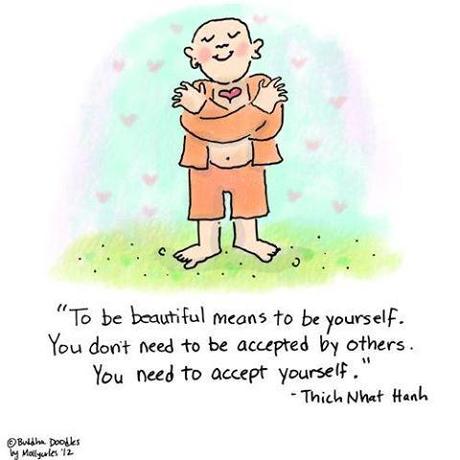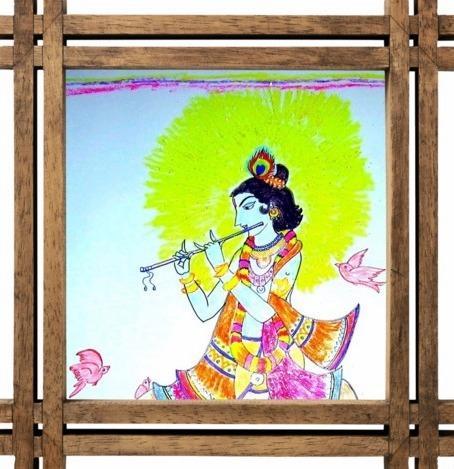
When I participated in the AtoZChallenge in April 2013, I chose to write about the Bhagavad Gita for the letter B. Little did I know that I would be meeting Vrindavan Rao, a fabulous blogger with whom I connected when she came over and commented on that post. I visited her blog right away and found it fascinating. She has an amazing understanding of the Gita (it takes solid dedication) and I simply loved the way she interpreted the verse first, and then described it in layman’s terms, often using apt metaphors. I mentally made a note that I must invite her over to guest post.
Today I am delighted to welcome Vrindavan Rao, author of Everyday Gita She describes herself as an “adventurer at heart”. She loves traveling, discovering and uncovering lost treasures. She explores and uncovers the gems of each verse of the Bhagavad Gita – as it is, on her blog.
Welcome, Vrindavan!
Bhagavad Gita – Practical Yoga
by Vrindavan Rao
Bhagavad gita Verse 6.6: For him who has conquered the mind, the mind is the best of friends; but for one who has failed to do so, his mind will remain the greatest enemy.
The great yoga text, the Bhagavad Gita, is very unique. In fact, if I had to describe it in just two words, I would probably choose: practical yoga.
The word practical implies that something is understandable and actually doable; the word yoga means to connect or link up. Therefore, the Gita is offering all of us a practicable process by which we can connect to our true selves (i.e the soul) and the Divine.

Thank you, Molly Hahn
Now, in order for any process to be followed, it’s important to know what challenges one might encounter. One of those challenges is brought up in today’s verse: the mind.
Now I don’t know about your mind, but my mind is more often than not my worst enemy! In order to link up to or establish a relationship with anyone or anything (whether it be a person or an idea), takes a great investment of knowledge, time and patience. Note that none of those qualities and things comes quickly. This is where the challenge lies.
As many of you might have experienced, an untrained mind tends to jump from the past to the future. It’s very hard for it to stay focused on the present moment and equally challenging for it to think long-term. The Gita offers insight as to why the mind behaves this way.
The mind is the leader of the senses. Our senses are always craving interaction with sense objects in order to derive some pleasure. Now you might be wondering, “What’s the harm in that?” Firstly, it can prevent one from achieving long term goals and secondly, it doesn’t take into account that our senses are limited. For example, the tongue likes to taste nice things but there is only so much one can eat before that sensation of pleasure turns to pain due to the stomach protesting.
Therefore, any pleasure derived from the senses is temporary. As souls, we crave permanency, not temporality and that’s why the Gita compels one to look beyond the fleeting happiness we may derive from the senses. But in order to do that, one needs to learn to control the mind.

The two essential tools one needs in order to control the mind are these:
- Practice
- Detachment
We constantly get opportunities to ignore the mind demands and many times might fail. For example, we may be committed to an exercise schedule but when the time comes to leave the house to go to the gym, we might listen to our minds and indulge in a brownie and watch tv instead. Practice means recognizing when and if we fail and trying to do better next time.
Detachment means to realize that we are the eternal soul and not the external packaging of the body; this comes from practicing mantra meditation and hearing from advanced bhakti yoga practitioners. When we start to identify ourselves as eternal, then we become more aware of the fact that temporary happiness is not as satisfying as we thought it was. That in turn can act as an impetus for one to seek out how we can tune into the limitless happiness that is lying dormant within.
So, coming back to my description of the Bhagavad Gita being “practical yoga”, I also say this because it is applicable to everyone. These tips in controlling the mind can help anyone whether they wish to achieve eternal happiness or whether they just want to become a more focused and centered individual. If you’d like to make your mind your best friend, feel free to try it out!
Thank you, Vrindavan!
 Vrindavan Rao was born into the bhakti tradition and grew up enveloped in it. However, her personal discovery of the bhakti path began in 2004 when she had the opportunity to go to a Vedic College in Belgium and since that time she has embraced it completely. Her love for travel has given her the opportunity to study Vedic texts, such as the Bhagavad-gita, in places such as India, Canada, Belgium, Ukraine and the United States under the guidance of several advanced practitioners. She especially loves the Bhagavad Gita and refers to it as her “Guidebook for Life” since it contains practical answers for complicated questions and is currently writing a daily blog on every verse of the Gita! In addition, you can keep track of all the happenings of EverydayGita on Facebook and via Twitter.
Vrindavan Rao was born into the bhakti tradition and grew up enveloped in it. However, her personal discovery of the bhakti path began in 2004 when she had the opportunity to go to a Vedic College in Belgium and since that time she has embraced it completely. Her love for travel has given her the opportunity to study Vedic texts, such as the Bhagavad-gita, in places such as India, Canada, Belgium, Ukraine and the United States under the guidance of several advanced practitioners. She especially loves the Bhagavad Gita and refers to it as her “Guidebook for Life” since it contains practical answers for complicated questions and is currently writing a daily blog on every verse of the Gita! In addition, you can keep track of all the happenings of EverydayGita on Facebook and via Twitter.
Her background is in science and she not only has a Bacherlor’s degree in Biochemistry, but also a Masters in Laboratory Medicine and Pathobiology. In her free time she loves to read, write, meditate, offer workshops on bhakti yoga and lead kirtan.
Question for you, dear readers:
What do you think of Practical Yoga as described by Vrindavan?
Please share your thoughts in your comment!


